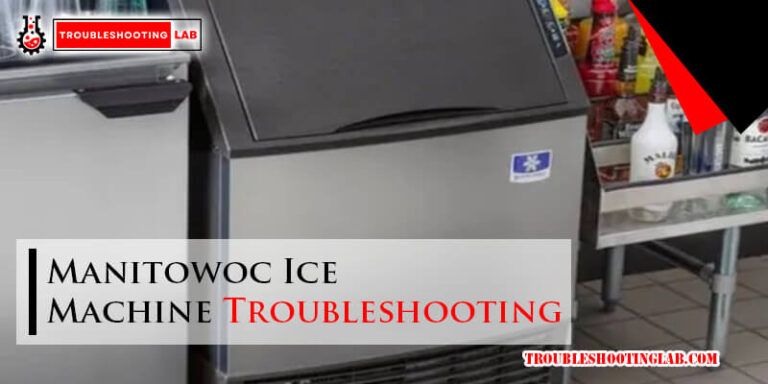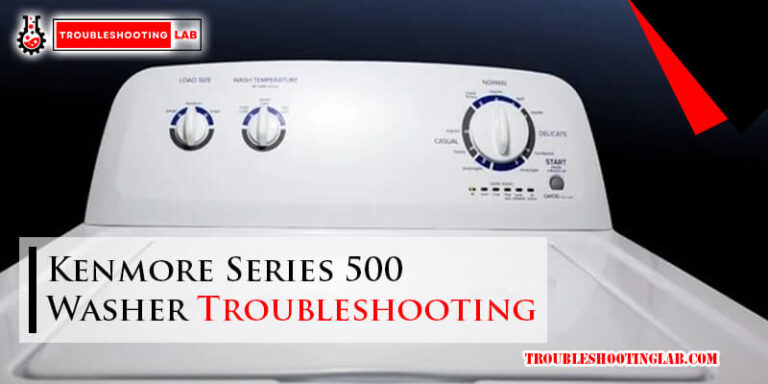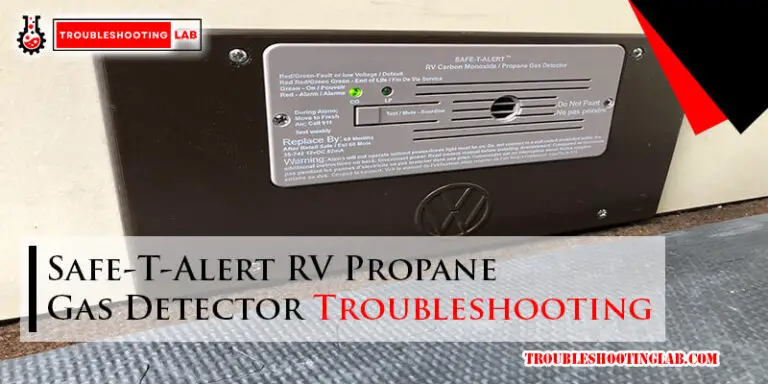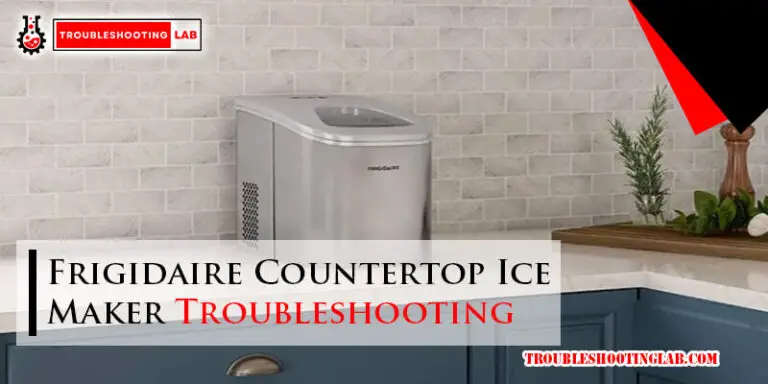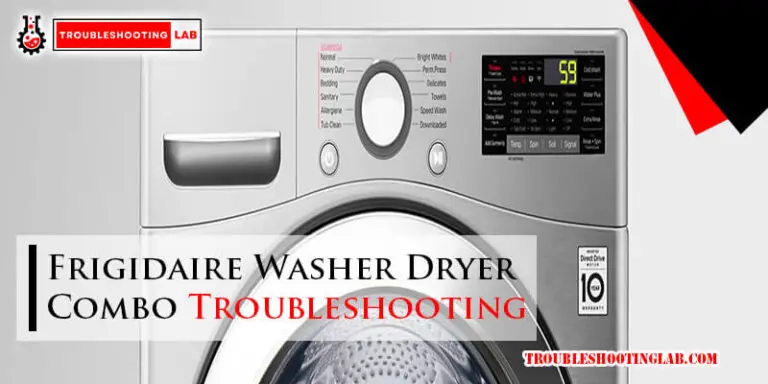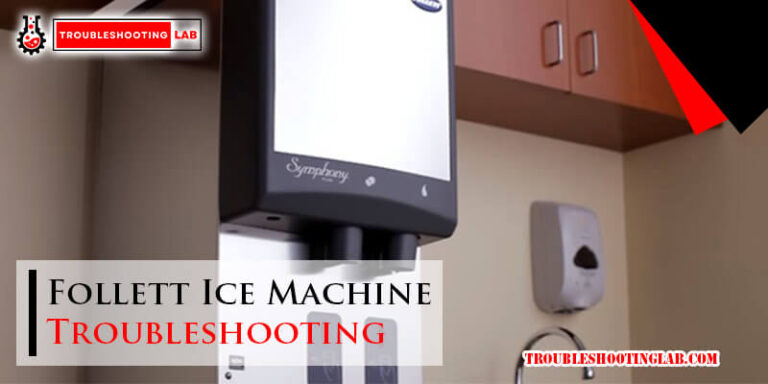Sub Zero Ice Maker Troubleshooting: A Step-by-Step Guide
Having trouble with your Sub Zero Ice Maker? Check the water filter, ice bucket placement, ice level arm position, fill tube for freezing, and water supply lines.
Make sure there are no obstructions in the ice maker. For more specific troubleshooting information, refer to the product’s manual or contact Sub Zero customer support. Properly maintaining your ice maker can ensure it functions efficiently and provides you with a steady supply of ice when needed.
Sub Zero ice makers are known for their quality and reliability, but like any appliance, they can occasionally experience issues. This can be frustrating, especially when you rely on your ice maker for everyday use. In this guide, we will go through common troubleshooting steps to help you identify and fix the problem with your Sub Zero ice maker. By following these steps, you can avoid costly repairs and ensure your ice maker continues to work smoothly.

Common Issues With Sub Zero Ice Maker
Sub Zero ice makers are known for their reliability and high-quality ice production. However, like any appliance, they can sometimes encounter issues that affect their performance. In this section, we will explore some of the common issues that you may encounter with your Sub Zero ice maker.
No Ice Production
If your Sub Zero ice maker is not producing any ice, there are a few potential causes to investigate:
- Check the water supply. Ensure that the water supply to the ice maker is connected and turned on. Make sure the water valve is not clogged or restricted.
- Inspect the water filter: A clogged or dirty water filter can hinder water flow and affect ice production. Replace the water filter if necessary.
- Examine the water inlet valve. A faulty water inlet valve can prevent water from reaching the ice maker. Test the valve for continuity and replace it if needed.
Low Ice Production
If your Sub Zero ice maker is producing ice but at a lower rate than normal, consider the following possibilities:
- Check the temperature settings: Ensure that the freezer temperature is set to the recommended level. A higher than recommended temperature can hinder ice production.
- Inspect the condenser coils. Dirty or clogged condenser coils can affect the efficiency of the ice maker. Clean the coils to improve performance.
- Examine the ice mold thermostat. A malfunctioning thermostat can cause low ice production. Test the thermostat for continuity and replace it if necessary.
Small Ice Cubes
If your Sub Zero ice maker is producing small or misshapen ice cubes, consider the following possible causes:
- Check the water pressure. Low water pressure can result in smaller ice cubes. Ensure that the water supply pressure is within the recommended range.
- Inspect the water inlet valve. A faulty water inlet valve can restrict water flow to the ice maker, resulting in undersized ice cubes. Test the valve for continuity and replace it if needed.
- Examine the ice mold thermostat. A malfunctioning thermostat can cause the ice maker to produce smaller ice cubes. Test the thermostat for continuity and replace it if necessary.
Ice Dispenser Not Working
If the ice dispenser on your Sub Zero refrigerator is not working, consider the following troubleshooting steps:
- Check for any ice blockages. Clear any ice that may be blocking the dispenser chute or dispenser motor.
- Inspect the dispenser motor. A faulty dispenser motor can prevent ice from being dispensed. Test the motor for continuity and replace it if needed.
- Examine the dispenser switch. A malfunctioning switch can also hinder ice dispensing. Test the switch for continuity and replace it if necessary.
Ice Maker Leaking
If you notice water leaking from your Sub Zero ice maker, consider the following potential causes:
- Check the water supply line. Inspect the water supply line for any leaks or damages. Replace the supply line if necessary.
- Inspect the water inlet valve. A faulty water inlet valve can cause water to leak. Test the valve for leaks and replace it if needed.
- Examine the ice maker assembly: Check for any cracks or damages in the ice maker assembly that could lead to leaks. Replace the assembly if necessary.
1. Check the power supply and connection.
When your Sub Zero ice maker is not functioning properly, the first step in troubleshooting is to check the power supply and connection. Without a proper power supply, your ice maker may not be able to produce ice or function as intended. In this section, we will go through the necessary steps to ensure that the power supply and connection are in order.
Ensure The Ice Maker Is Properly Plugged In
The first thing you should check is whether your ice maker is properly plugged into a power source. Sometimes, a loose or unplugged power cord can easily go unnoticed, leading to the ice maker not working. Make sure that the plug is securely inserted into the power outlet and that there are no visible signs of damage to the cord.
Verify There Is a Power Supply To The Ice Maker
Simply plugging in the ice maker might not always guarantee a power supply. There could be an issue with the electrical outlet or circuit breaker. To ensure that there is power reaching the ice maker, you can follow these steps:
- Check if the power outlet is working properly by plugging in a different appliance or device.
- If the power outlet is functional, move on to checking the circuit breaker. Locate the circuit breaker panel in your home and check if the breaker associated with the ice maker outlet is flipped to the “ON” position. If it is in the “OFF” position, flip it back to “ON” and then try your ice maker again.
- If the power outlet and circuit breaker are both functioning correctly, but your ice maker still isn’t getting power, it may be a problem with the ice maker itself. In this case, you may need to contact a professional technician for further assistance.
By following these simple troubleshooting steps, you can quickly determine if the power supply and connection are the cause of your Sub Zero ice maker’s malfunction. Remember to always prioritize safety while dealing with electrical appliances and consult a professional if needed.
2. Check the water supply.
One of the common causes of issues with a Sub Zero ice maker is an improper water supply. In this step, we’ll walk you through some troubleshooting steps to ensure the water supply is working efficiently for your ice maker.
Check If The Water Supply To The Ice Maker Is Turned On
The first thing you need to do is check if the water supply to your Sub Zero ice maker is turned on. This may seem obvious, but sometimes simple oversights like this can cause problems. To do this, locate the shut-off valve that supplies water to your refrigerator and make sure it is fully open. Ensure that there are no kinks in the water line leading to the ice maker as well.
Inspect The Water Line For Any Kinks Or Blockages
If the water supply is turned on but you still don’t have any ice, it’s time to inspect the water line for any kinks or blockages. Check the entire length of the water line and ensure that it is free from any obstructions. If you notice any kinks or bends in the line, straighten them out to ensure a steady water flow.
Test The Water Pressure To Ensure It Is Suitable For Ice Making
Another factor to consider is the water pressure going into your ice maker. Low water pressure can lead to slow or no ice production. To test the water pressure, you’ll need a water pressure gauge. Attach the gauge to the water supply line and turn on the water. The ideal water pressure for making ice is typically around 20–120 pounds per square inch (psi). If the water pressure is below this range, you may need to contact a plumber to address the issue.
By following these troubleshooting steps, you should be able to identify and resolve any water supply issues that may be affecting the performance of your Sub Zero ice maker. Remember to always consult the user manual provided by Sub Zero for specific instructions and additional troubleshooting tips. If the problem persists, it may be best to reach out to a professional technician for further assistance.
3. Clean The Ice Maker
Regularly cleaning your Sub Zero ice maker is essential to ensuring it continues to produce fresh and clean ice. Over time, ice can build up, causing performance issues and affecting the taste and quality of the ice. Follow these steps to effectively clean your ice maker:
Remove Any Excess Ice Or Frost From The Ice Maker
To begin the cleaning process, you need to remove any excess ice or frost that may have accumulated in the ice maker. This buildup can hinder ice production and lead to clogs or reduced ice output. Here’s how to do it:
- Gently open the ice maker door or remove the ice bin from the freezer compartment.
- If you notice any large clumps of ice or frost, carefully break them up using a plastic utensil or ice scoop. Be cautious not to damage any internal components.
- Once you have removed the excess ice or frost, take a clean cloth or paper towel and wipe down the interior of the ice maker to remove any remaining moisture.
- Close the ice maker door or reinstall the ice bin securely.
Clean The Ice Bin And Dispenser
The ice bin and dispenser can accumulate dirt, residue, and other contaminants over time. Cleaning these components will help maintain the cleanliness and quality of your ice. Here’s how to do it:
- Remove the ice bin from the freezer and empty any remaining ice.
- Wash the ice bin with warm, soapy water, ensuring it reaches all corners and crevices. You can use a soft cloth or sponge for this task.
- Rinse the ice bin thoroughly with clean water to remove any soap residue.
- Dry the ice bin completely before placing it back in the freezer.
- Using a damp cloth, wipe down the exterior of the ice dispenser, paying close attention to the buttons and handles.
- Lastly, sanitize the ice bin and dispenser by wiping them down with a mixture of equal parts water and white vinegar. This will help eliminate any lingering bacteria or odors.
Remove And Clean The Ice Maker Components According To The Manual Instructions
Periodically, you’ll need to go a step further and clean the internal components of your Sub Zero ice maker. The specific steps for this process may vary depending on the model of your ice maker. It is essential to consult your Sub Zero ice maker’s manual for detailed instructions on how to disassemble and clean the components safely. Here are some general guidelines to follow:
- Turn off the ice maker or unplug the unit from the power source to ensure your safety during the cleaning process.
- Refer to the manual to identify the specific components to remove and clean. Commonly cleaned parts include the ice mold, water fill tube, water reservoir, and the ice level arm.
- Gently remove the components as instructed, being careful not to force or damage anything.
- Clean the removed components using warm, soapy water, making sure to remove any dirt, debris, or mineral deposits.
- Rinse the components thoroughly with clean water to remove any soap residue.
- Dry the components completely before reassembling them according to the manual instructions.
Regularly cleaning your Sub Zero ice maker not only ensures its proper functioning but also helps maintain the quality and taste of your ice. By following these steps and referring to your ice maker’s manual, you can ensure that your ice maker stays clean and continues to produce fresh ice for your drinks and cooling needs.
4. Check For Malfunctioning Components
A malfunctioning ice maker can be frustrating, but before you rush to call a technician, there are a few simple troubleshooting steps you can try to identify and resolve the issue. One of the first things you should do is check for malfunctioning components. Here are three key components to examine:
Examine the water inlet valve for any clogs or damage
The water inlet valve is responsible for supplying water to the ice maker. Over time, it can become clogged with debris or damaged, leading to decreased water flow or no water at all. To check for any clogs or damage, follow these steps:
- Locate the water inlet valve, which is usually located at the back of the refrigerator.
- Inspect the valve for any visible clogs or signs of damage, such as cracks or leaks.
- If you notice any clogs, use a small brush or toothbrush to gently remove the debris.
- If the valve is damaged, it will need to be replaced. Refer to the manufacturer’s manual or contact a professional for assistance.
Inspect the ice maker motor and gears for any signs of wear or malfunction
The motor and gears of the ice maker are essential components that ensure the proper functioning of the ice-making process. Over time, these components can wear out or become misaligned, leading to issues with ice production. To inspect the motor and gears, follow these steps:
- Remove the ice maker from the freezer. Refer to the manufacturer’s manual for specific instructions.
- Visually inspect the motor and gears for any signs of wear, such as rust, loose connections, or broken parts.
- If you notice any issues, contact a professional technician to repair or replace the motor and gears.
Test the ice maker thermostat and heater for proper functioning
The thermostat and heater are responsible for regulating the temperature and ensuring proper ice formation. If either of these components is not functioning correctly, it can result in ice production problems. To test the ice maker thermostat and heater, follow these steps:
- Remove the ice maker from the freezer and disconnect any power sources.
- Locate the thermostat and heater components, which are typically attached to the ice maker.
- Use a multimeter to test the continuity of each component. If there is no continuity, it indicates a faulty component that needs to be replaced.
- If you are unsure how to test these components or do not have a multimeter, it is best to contact a professional for assistance.
By checking these malfunctioning components and addressing any issues, you can save time and money by potentially resolving the problem without the need for professional help. However, if you are unable to identify or fix the issue on your own, it is advisable to consult a technician who specializes in ice maker repair for further assistance.
5. Reset The Ice Maker
If your Sub Zero ice maker is not working as expected, resetting it might resolve the issue. Resetting the ice maker can clear any temporary glitches or malfunctions that are preventing it from producing ice. Follow the steps below to reset your Sub Zero ice maker.
Power Cycle The Ice Maker To Reset It
The first step to resetting your Sub Zero ice maker is to power cycle it. This process involves turning off the ice maker, unplugging it from the power source, and waiting for a few minutes before plugging it back in and turning it on again. Power cycling the ice maker helps reset its internal settings and can often resolve minor issues.
To power cycle your Sub Zero ice maker, follow these steps:
- Locate the power cord at the back of the ice maker.
- Unplug the power cord from the electrical outlet.
- Wait for approximately 5 minutes.
- Plug the power cord back into the electrical outlet.
- Turn on the ice maker and wait for it to initialize.
Follow The Manufacturer’s Instructions To Perform A Manual Reset If Necessary
If power cycling the ice maker does not resolve the issue, you may need to perform a manual reset. The steps for a manual reset may vary depending on the model of your Sub Zero ice maker. To perform a manual reset, consult the user manual or visit the manufacturer’s website for specific instructions.
It is important to adhere to the manufacturer’s instructions to avoid causing any further damage to the ice maker. The manual reset process may involve pressing certain buttons or toggling specific settings on the ice maker’s control panel.
To perform a manual reset, follow the instructions provided by the manufacturer for your specific Sub Zero ice maker model.
Resetting your Sub Zero ice maker can often resolve common issues and get it back to producing ice efficiently. Try power cycling the ice maker first, and if necessary, consult the manufacturer’s instructions for a manual reset.
Additional Tips And Tricks
Cleanliness plays a vital role in ensuring the smooth operation of your Sub Zero ice maker. Regularly cleaning the ice maker and its components will help prevent the buildup of dirt, debris, and mineral deposits that can lead to blockages and affect ice production. Here are some essential cleaning steps to follow:
Regularly Clean The Ice Maker And Its Components To Prevent Buildup And Blockages
To keep your ice maker in optimal condition, follow these cleaning tips:
1. Start by unplugging the ice maker or switching off its power source.
2. Remove the ice bin and any ice cubes from the ice maker.
3. Use warm, soapy water and a soft cloth to clean the interior and exterior surfaces of the ice maker.
4. Pay special attention to the ice chute, dispenser, and ice tray, as these areas are prone to buildup.
5. Rinse off any residue with clean water to ensure all soap is removed.
6. Allow all parts to air dry completely before reassembling the ice maker and plugging it back in.
Ensure The Freezer Temperature Is Set Correctly For Optimal Ice Production
The freezer temperature directly affects the performance of your ice maker. Make sure the temperature is set correctly by following these steps:
1. Locate the temperature controls on your Sub Zero refrigerator. Refer to the owner’s manual if you’re unsure.
2. Ensure the freezer temperature is set between 0 and 5 degrees Fahrenheit (-18 to -15 degrees Celsius) for optimal ice production.
3. Use a thermometer to verify the temperature accuracy and make adjustments accordingly.
4. Avoid setting the temperature too low, as it can cause excessive ice buildup and impede ice production.
Use Filtered Water To Avoid Any Impurities That Can Affect Ice Quality
The quality of water used in your Sub Zero ice maker can significantly impact the taste and clarity of the ice produced. Using filtered water can help eliminate impurities and ensure high-quality ice. Consider the following:
1. Install a water filtration system to provide clean and pure water to the ice maker.
2. Change the water filter regularly according to the manufacturer’s instructions to maintain its effectiveness.
3. If a filtration system is not an option, you can use bottled, distilled, or filtered water from a pitcher to make ice.
Remember, following these additional tips and tricks will not only keep your Sub Zero ice maker running smoothly but also ensure that you consistently enjoy clear and refreshing ice for all your beverages.
Frequently Asked Questions
How Do I Reset My Sub-zero Ice Maker?
To reset your Sub-Zero ice maker, power cycle the product. Turn off the ice maker, unplug the unit for 30 seconds, and then plug it back in. Ensure that the ice maker water fill tube is not blocked and that there are no obstructions or jammed ice cubes. Refer to the manual for further instructions.
Why is the sub-zero ice maker not making ice?
If your Sub-Zero ice maker is not making ice, first make sure it’s not blocked or jammed. You may need to defrost the freezer or clear the ice maker manually. Also, check that the water-filled tube is not blocked.
Resetting the ice maker or turning it on or off may also help.
How can I reset my ice maker?
To reset your ice maker, you need to power cycle the Sub-Zero refrigerator. Turn off the refrigerator, unplug it for 20 seconds, and then plug it back in. This should reset the ice maker and resolve any issues.
How Do I Turn On The Ice Maker On My Sub-zero Refrigerator?
To turn on the ice maker on your Sub-Zero refrigerator, simply touch the Ice On/Off key on the control panel. The LCD screen will show the word “ICE” next to the freezer temperature readout, indicating that the ice maker is now turned on.
Why Is My Sub Zero Ice Maker Not Making Ice?
If your Sub Zero ice maker is not making ice, check for obstructions, clear jammed ice cubes, and ensure the water-filled tube is not blocked.
Conclusion
To troubleshoot your Sub Zero ice maker, start by checking the water filter, ensuring the ice bucket is properly placed, and confirming that the ice level arm is in the down position. Next, check if the fill tube is frozen or if any ice is obstructing the exit.
Finally, examine the water supply lines for any issues. By following these troubleshooting steps, you can effectively address the problem with your Sub Zero ice maker and get it back to producing ice efficiently.

